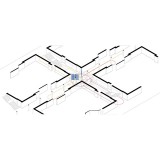Supervisor:
2023
This research work focuses its interest on the choreographic work of Anne Teresa de Keersmaeker and especially on the way in which she manages the stage space and on the choreographic tools she uses to construct a choreography. This is done in the light of two works of the choreographer. The basic principles of the space-movement relationship set by Rudolf von Laban through Labanotation, the system of analysis and recording of movement, are examined.
As she herself has said, choreography is the organization of movement in space and time. The space is shaped together with the movement throughout the construction of a choreography. In addition, the main interest of this research is the finding that a choreography is a function of two spatial relationships, one relationship is that of the space organized by marches on the ground and on which a choreography is based, and the second is the space that it produces choreography as a three-dimensional movement in space and time.
Finally, as a result of the research, a choreography is produced in the central corridor of the TAM school, where the most basic daily movements intersect. The choreography arises from the structure of the corridor space, while at the same time it can create new spatial relationships and movement possibilities. Space is what gives the instruction according to which bodies move within it. This choreography is confronted with 3 components: the reading of the space in a top view, the choreography resulting from the choreographic tools of Anne Teresa de Keersmaeker and the seminar with Marta Coronado combined with the daily movements that occur in the corridor and the question of what remains after a choreography is over.
